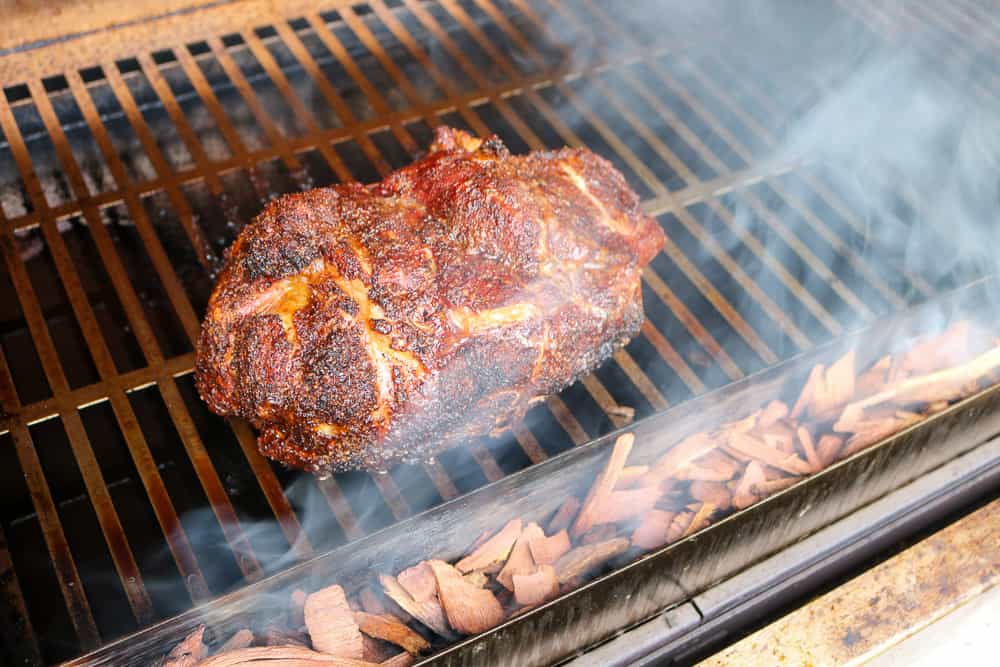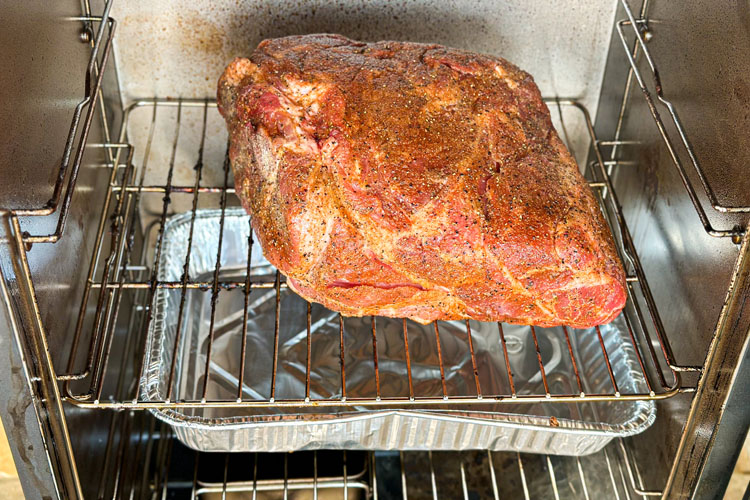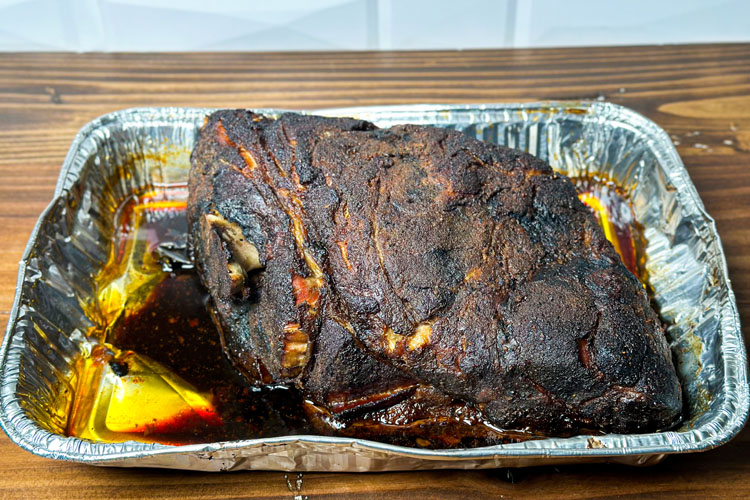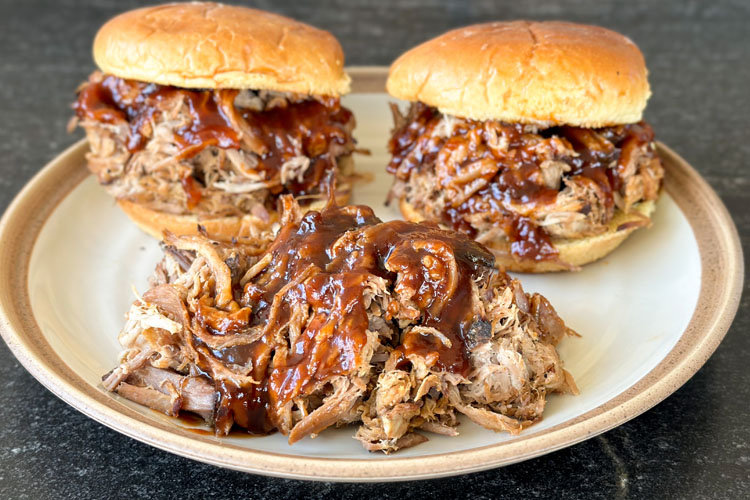I learned how to smoke pulled pork the first time I got into barbecue, and I think a lot of other pit masters did the same.
It’s now on my go-to list, it’s affordable and really easy to make. The electric smoker is one of my favorite ways to smoke pulled pork, and it always comes out great.
I’m going to show you how to make tasty pulled pork at home in an electric smoker with only a few simple ingredients. This process is straightforward and you’ll have it down pat in no time.
Making perfect pulled pork requires getting the right balance of smoke flavor. Adding wood chips to your smoker or grill is key for infusing your pork with that quintessential smoky taste. But it can be tricky to know exactly when to stop adding more chips. Under-smoke your pork and it will lack depth of flavor. Overdo it on the smoke and your pulled pork can end up bitter. So when is the right time to stop adding more wood chips? This article will give you tips on identifying when your pulled pork has absorbed enough delicate smoky essence.
The Importance Of Smoke In Pulled Pork
First, let’s talk about why smoke flavor is so integral to pulled pork in the first place. The smoking process bathes the pork in smoldering wood smoke over low, indirect heat for an extended period of time. This slow infusion of smoke into the meat results in succulent, fall-apart tender pork with a wonderfully smoky flavor. The smoke coagulates the proteins on the exterior of the meat, forming the flavorful, slightly chewy bark. It also gently seasons the interior meat, providing nuanced smoky notes in every bite. Smoke is unmistakably one of the defining characteristics of authentic pulled pork.
Choosing Your Wood Chips
To start out on the right foot, you’ll want to choose the right type of wood chips to complement the natural flavor of pork Here are some top options
-
Hickory – The most classic choice, provides a robust, bacon-like flavor
-
Apple – Imparts a mildly sweet, fruity smoke flavor.
-
Cherry – Similar to apple, but slightly more pronounced fruitiness.
-
Pecan – Subtler and more nutty than hickory.
-
Mesquite – An intense, earthy smoke flavor. Use sparingly or it can overwhelm.
We recommend starting with a fruit wood like apple or cherry for a milder smoke that works well with pork. Hickory is another sure bet. Stay away from heavier smoke woods like mesquite, which can easily make your pulled pork taste bitter if overdone.
Adding The Wood Chips
Now let’s get to the technique of when and how often to add wood chips. There are two main approaches:
1. Add from the start: Lay wood chips over the charcoal or propane flame from the beginning. Replenish the chips continuously over the course of the long, slow smoking time.
2. Only add for first few hours: Get the smoke flavor you want in the initial stage, then stop adding chips and finish cooking.
We tend to prefer method #1 for pulled pork, since maintaining a constant supply of thin smoke over many hours really allows the meat to gradually absorb the smoke essence. However, both approaches can work well.
For the continuous smoke method, add a small handful or about 1/2 cup of soaked wood chips every 30-60 minutes to maintain a steady, wispy smoke. Keep the smoker temp between 225-250°F. The lower heat helps draw out the smoking time.
If you prefer to concentrate the smoke early on, add chips more frequently at first, such as every 15-30 minutes for the first 2-3 hours of cooking. You can still finish cooking at a low smoker temp after that for tender, fall-off-the-bone meat.
How To Tell When Your Pork Has Enough Smoke
Judging precisely when your pulled pork has absorbed enough smoke can take some trial and error. Here are some signs to look out for:
-
Bark formation – The bark should be well formed, dark and slightly charred. If the bark is still pink or pale, keep smoking.
-
Smoke ring – Look for a pink smoke ring about 1/4 to 1/2 inch deep. This indicates thorough smoke penetration.
-
Color – The meat should be mahogany brown, not pink or pale.
-
Smoky aroma – You should smell strong smoky notes from the meat.
-
Flavor – Taste samples as you go. You want a distinct smoky flavor without excessive bitterness.
-
Internal temp – Once you hit 195-205°F, the meat won’t absorb much more smoke flavor.
When in doubt, it’s better to err on the side of more smoke rather than less for pulled pork. You can always serve it with barbecue sauce or other condiments to balance the smoke if it’s slightly overdone.
Other Tips For Perfectly Smoked Pulled Pork
Here are a few more tips to nail the perfect smoke level every time:
-
Maintain an even, consistent temperature in your smoker.
-
Use a meat thermometer to monitor internal temp.
-
Spritz with apple cider vinegar every hour for enhanced moisture and flavor.
-
Allow the pork to rest for 30-60 minutes before pulling to allow juices to redistribute.
-
Pull, chop and serve with flavorful barbecue sauce on the side.
-
Refrigerate leftovers within 2 hours to prevent bacteria growth.
Mastering the art of smoked pulled pork does involve some trial and error. We hope these guidelines give you more confidence to hone in on just the right quantity of smoke to bring this BBQ classic to life. Now get outside and start perfecting your technique! Let us know how it turns out.

Pulled Pork in the Electric Smoker
- Pork butt: Choose a cut between 8-10lb. A boneless pork butt will work just as well, but I like mine with the bones in. It’s best to pick a piece that has a good amount of marbling and a flat shape so that it cooks evenly.
- I always put down a layer of SPG first, and then I put down a layer of sweet pork rub on top of that.
- Apple juice: to use as a spritz
- For this cook, I used the Cuisinart COS 330 electric smoker.
- It’s hard to beat pecan and cherry wood chips for pulled pork. The pecan adds a savory note, and the cherry adds sweetness and color. It’s a winning combination if you’ve never tried it.
- Place a foil pan under the pork butt while it smokes to catch the juices. Then, when I wrap it,
- Spray bottle: for spritzing with apple juice.
From Our Shop
Keep your barbecue nice and moist with this 68 OZ pressurized spritz bottle.
- Control spray from a fine mist to a solid stream
Fire up the smoker
Set up your smoker by preheating it to 250°F.
Fill up your water pan and add your pecan and cherry wood chips.
When smoking with an electric smoker I opt to use wood chips instead of chunks. I don’t soak my chips in water. I want them to burn clean instead of smoldering, I think that results in a better flavor.
Also, make sure you have a foil pan underneath the grate where the pork butt will be. This will catch the drippings and help keep your smoker clean.
Stick a temperature probe into the pork butt and place it on the grate with the fat side down. This way, you won’t have to keep opening the door to check on the temperature.

Spritz the pork with apple juice or water if the bark looks dried out. Just be careful not to spritz too much as the chamber inside most electric smokers is pretty moist. If you spray too often you will not be able to build your bark properly. Essentially the surface will not be dry enough.
Once the pulled pork has reached at least 165°F and the bark has fully formed, it’s time to wrap it.
I typically take my pork to about 175-180°F before wrapping. On top of the pork, I put a foil pan and added a half cup of apple juice. Then I wrapped it tightly in foil.
Place it back into the smoker to finish. If you want your pork to shred apart like butter, you will need to take it to 205°F. Probe a few spots with an instant read thermometer to make sure.
Resting your pork is crucial. I take off the foil and put a thin tent over the pork while it’s sitting on my counter.
At least an hour should pass before cooking the pork. If you have time and can handle it, two hours is even better!

You know you did it right if you can pull the bone out and it comes out clean. If it’s hard to pull the bone out or there’s meat still attached, the pork might not be cooked all the way through.
To pull or shred the pork I wear latex gloves with cotton glove liners. The cotton gloves underneath ensure my hands don’t burn. Then I just shred apart the pork with my hands and pick apart any unwanted fat.
Taste the pork and make sure it doesn’t need any extra seasoning. Sometimes it will. Just add a little bit more rub to the pulled pork and adjust accordingly.

When Adding Additional Wood Chips to Masterbuilt Electric Smoker …
FAQ
How long do you keep adding wood chips when smoking?
How long to smoke pork butt at 225?
When to stop adding wood to smoker for brisket?
Do you add wood chips when preheating a smoker?
How do you repurpose pulled pork?
Use bear claw shredders to tear into the pork. Use claws to shred the pulled pork. If you find any large chunks of fat, throw them away. If you find any bark, be generous and spread it around evenly for your guests. If you have any leftover juice from the cook, repurpose it by pouring it back over the meat.
Why is pork not recommended to eat?
This is not true, some cuts like sirloin and pork rump steak, for example, are very healthy, even healthier than beef and chicken. Only the fattest cuts like bacon and crackling should be avoided.
Is apple wood good for pulled pork?
Apple wood is popular in North America for its sweet, fruity flavor and for delivering just a hint of smokiness that is ideal for slow-cooked dishes like pulled pork. If you’re not sure if your crowd is into smoke, default to apple for pulled pork. Plus, what could be more classic than apple and pork?
Can you eat pulled pork at 145 degrees?
Technically, pork is safe to eat once it hits 145°F, but we need pork shoulder to be well done to reach a level where we can ‘pull’ it. At 203°F it’s at its most tender and the perfect texture we look for in pulled pork. Apple or pecan wood chips are the best woods for smoking pulled pork.
